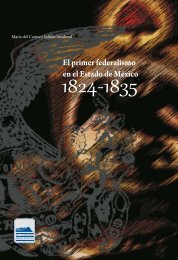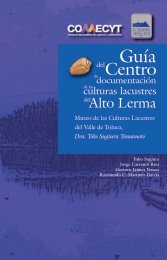Korpus 21 - Vol. 3
Korpus 21 - Nuevas interpretaciones acerca de la consumación de la Independencia.
Korpus 21 - Nuevas interpretaciones acerca de la consumación de la Independencia.
Create successful ePaper yourself
Turn your PDF publications into a flip-book with our unique Google optimized e-Paper software.
JOHN TUTINO, 18<strong>21</strong>: THE END OF NEW SPAIN, DREAMS OF AN IMPOSSIBLE MEXICO<br />
se. Any call for a rising to confront that response<br />
would mobilize people angered by<br />
predations pressed by landed power holders<br />
–including many among those seeking<br />
political rights. Fear of provoking a popular<br />
rising prevented the Querétaro debaters<br />
(they were never conspirators) from calling<br />
a revolt –enabling Mexico City authorities<br />
to learn of the debates and to detain many<br />
participants (Herrejón, 2011).<br />
Corregidor don Miguel Domínguez and<br />
his wife doña Josefa Ortiz had joined, at times<br />
hosted, Querétaro’s political debates.<br />
He acquiesced in the regime action; she sent<br />
the message that led don Ignacio Allende<br />
at San Miguel to join don Miguel Hidalgo in<br />
calling insurgency at Dolores on September<br />
15-16, 1810 –exactly two years after the 1808<br />
coup that militarized governance. The fears<br />
that stymied action at Querétaro proved<br />
true –immediately and massively. While a<br />
few provincial leaders joined the rising, backed<br />
by perhaps 1500 militiamen, within days<br />
tens of thousands of men from the countryside<br />
around Dolores, San Miguel, Celaya and<br />
beyond rose with machetes in hand. While<br />
leaders demanded political rights and targeted<br />
agents of Spanish power, insurgent<br />
throngs sacked estates, most owned and<br />
operated by American Spanish landed capitalists<br />
–often claiming crops they had planted<br />
but had no right to harvest to feed desperate<br />
families. The few fighting for political<br />
rights fueled hate against gachupines, aiming<br />
to deflect popular ire from landed men<br />
seen as potential political allies. As assaults<br />
on landed power spread despite anti-gachupín<br />
rhetoric, most landed provincials held<br />
back from the rising and Mexico City landed<br />
oligarchs mobilized to defend property and<br />
the regime (Tutino, in progress, Ch. 3).<br />
From its explosive beginning, the Hidalgo<br />
revolt was defined by fundamental contradictions.<br />
Its angry throngs sacked Guanajuato,<br />
approached Mexico City through the<br />
Toluca basin (where it found little support<br />
in local indigenous republics), retreated to<br />
the Bajío, sacked Guanajuato again, then occupied<br />
Guadalajara –where it found a home<br />
for several weeks, to be defeated at Puente<br />
de Calderón in January of 1811 by troops<br />
and militias drawn from the north and led<br />
by don Félix Calleja. Hidalgo and Allende<br />
fled north, to be captured, tried and executed.<br />
Other political rebels including don<br />
José María Morelos and don Ignacio Rayón<br />
escaped to isolated regions where they carried<br />
on for years. The great mass of insurgents<br />
returned home to the Bajío, planted<br />
crops, then rose early in 1812 to claim the<br />
harvest, take the land for family production,<br />
and sustain guerrilla forces. Insurgent communities<br />
and guerrillas would rule rural Guanajuato<br />
for years –guaranteeing that mining<br />
could not revive. Silver production across<br />
New Spain in 1812 was half that of 1809–a<br />
level that held to 1820 and long after. Silver<br />
mining, the economic engine of New Spain,<br />
the primary support of Spain’s empire, and<br />
an essential stimulus to global trades, died<br />
in the conflicts of 1808-1812 (Tutino, 1998;<br />
forthcoming, Ch. 3-4; Herrejón, 2011; Granados,<br />
2016).<br />
So did the mediating regime that had stabilized<br />
the dynamic inequities that marked<br />
New Spain: the coup of 1808 militarized the<br />
heights of power; the risings of 1810 militarized<br />
political and popular resistance; the<br />
mobilization led by Calleja to defeat Hidalgo<br />
locked armed power at the foundation<br />
of a contested regime. That was plain for all<br />
to see when Calleja became Viceroy in 1813<br />
–honored for the victory at Puente de Calderón,<br />
now recognized as essential to the<br />
survival of Spanish sovereignty (Ortíz Escamilla,<br />
2013, 2017).<br />
More than mining and the mediating regime<br />
broke from 1808 to 1812. Silver capitalism<br />
collapsed, too. That larger, globally<br />
linked system of finance and trade, mining<br />
and agriculture, not only broke –but did so<br />
in ways that blocked any revival. The key<br />
axis of silver capitalism tied New Spain’s<br />
silver to Chinese and South Asian textiles.<br />
The latter had led global cloth trades since<br />
the sixteenth century, purchased with silver<br />
drawn from New Spain that concentrated<br />
wealth, power, and capital in Mexico City.<br />
When New Spain’s silver exports fell by half<br />
from 1810 to 1812, and did not recover, Asian<br />
338



![bicentenario_1[V2]](https://img.yumpu.com/68677971/1/167x260/bicentenario-1v2.jpg?quality=85)
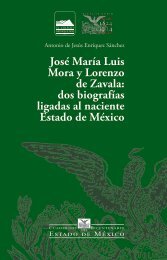
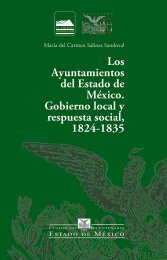

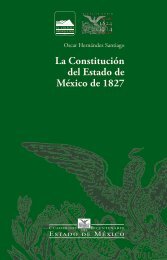
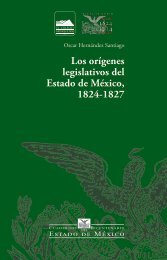
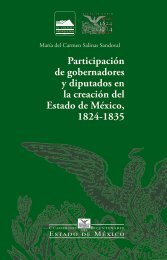
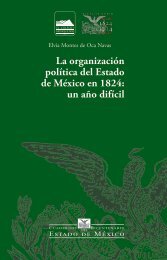
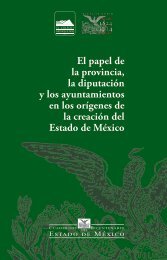

![El_primer_federalismoEM[final]_compressed (2)](https://img.yumpu.com/68483279/1/178x260/el-primer-federalismoemfinal-compressed-2.jpg?quality=85)
